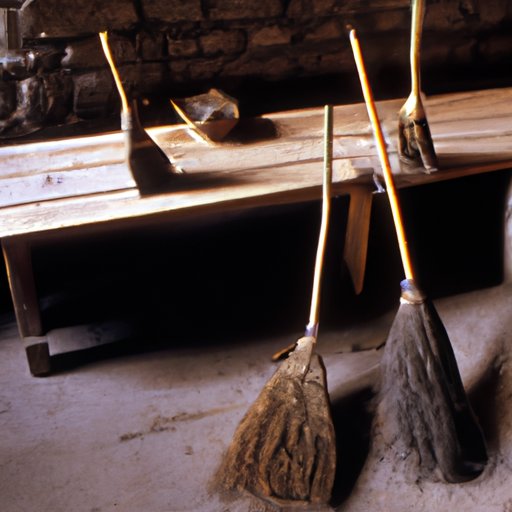Introduction
Have you ever wondered why witches are often depicted as riding brooms? Is it simply a stereotype or is there a deeper meaning behind it? In this article, we’ll explore the historical, mythological, symbolic, pop cultural, and psychological reasons behind this phenomenon. Understanding the history and symbolism of witches riding brooms can deepen our appreciation of the rich cultural heritage of witchcraft and reveal insights into the human psyche and its projections.
Historical Context
To understand why witches ride brooms, we need to look back at the origins of witchcraft and witch persecutions. In the Middle Ages and early modern period, women who were accused of practicing magic were often associated with domestic work, such as cooking and cleaning. The broom, which was a common household item, was thus deemed a fitting tool for these women to “fly” to their gatherings with the devil.
Folk beliefs about brooms being used for magic also date back to early European traditions. For example, some people believed that if a woman was sweeping a room at night and accidentally touched her foot with the broom, she would be transported to the sabbat or meeting place of witches. Additionally, some cultures believed that witches could fly on brooms or staffs that had been anointed with a special flying ointment, which was made from plants with hallucinogenic properties.
Mythological Beliefs
Aside from these folk beliefs, the concept of shamanic flight or astral projection is also found in many cultures around the world. The shaman, or spiritual healer, would use various tools, such as drums, rattles, and horns, to enter an altered state of consciousness and journey to other realms. In some traditions, the shaman would ride a broom or a similar object to facilitate this process.
The symbolism of brooms and other household objects in facilitating travel to other realms can also be found in pagan mythology. For example, the Norse goddess Freyja was said to ride a chariot pulled by two cats, while the Greek goddess Hecate was often portrayed holding a torch and a pair of serpents. In both cases, these goddesses were associated with magic, witchcraft, and the underworld.
Symbolism
In addition to their practical use for sweeping, brooms also have symbolic significance in witchcraft. One core theme of witchcraft is cleaning and purification, both on a physical and a spiritual level. Brooms were used to sweep away dirt and negativity from the home, creating a safe and sacred space for magic to be practiced. The sweeping motion was also seen as a form of casting spells, as the broom could be used to “sweep in” positive energy and “sweep out” negative energy.
The metaphorical meaning of “flying” on a broomstick also has multiple interpretations. Some scholars believe that the “flight” refers to the shamanic journey to other realms, where the witch would meet with spirits and ancestors. Others see it as a symbolic form of transcendence, where the witch could escape the confines of her mundane life and access a state of ecstasy and empowerment.
Pop Culture
The image of witches riding brooms has become a pop cultural icon, appearing in literature, art, and media. One of the earliest recorded mentions of the broomstick as a vehicle for witches comes from the Malleus Maleficarum, a notorious witch hunting manual from the 15th century. In the 20th century, the image was popularized in Hollywood films such as The Wizard of Oz and Disney’s Fantasia.
The commercialization of Halloween has also had a significant impact on the popularization of witchcraft and broom riding. Costumes and decorations featuring witches riding brooms can be found in many stores during the Halloween season, contributing to the continued fascination with this image.
Psychology behind the Pattern
So why do witches ride brooms? One explanation is that the image taps into our collective unconscious, or the universal symbols and archetypes that are present in all cultures and societies. The broom represents a connection to the earth and the mundane world, while flying represents a transcendence of those limitations. Thus, the image of a witch on a broomstick can evoke feelings of both grounding and liberation.
The psychological significance of “riding” can also be seen as a form of escape and empowerment. By riding a broomstick, the witch is able to distance herself from her everyday problems and tap into her inner strength and creativity. This can be a powerful tool for personal growth and transformation, as well as a way to connect with others who share these beliefs and practices.
The broom as a symbol and tool can also have healing and transformative power. By using a broom in ritual or meditation, one can connect with the energy of the earth and channel that energy for personal or collective purposes. The broom can be seen as a symbol of both physical and spiritual cleansing, as well as a reminder of the power of intention and visualization.
Conclusion
Overall, the history and symbolism of witches riding brooms is a fascinating topic that reveals insights into the human psyche and its projections. By exploring the historical, mythological, symbolic, pop cultural, and psychological reasons behind this phenomenon, we can deepen our appreciation of the rich cultural heritage of witchcraft and connect with the transformative power of the broom as a tool and symbol.
So when you see a witch riding a broomstick, remember that there is so much more to this image than meets the eye. Engage with the rich history and symbolism of witches and brooms in your own life and community, and see where this powerful archetype can take you.
